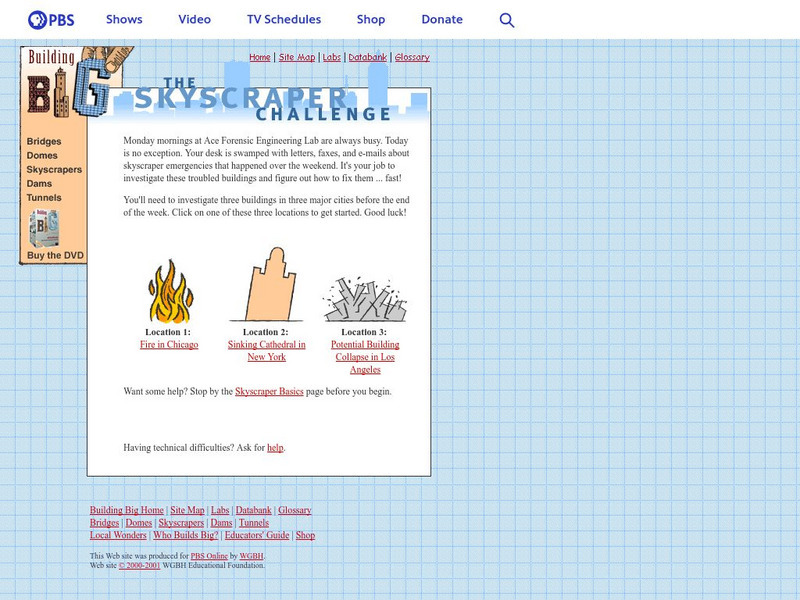Hi, what do you want to do?
PBS
Pbs Learning Media: The Skyscraper Challenge
In this interactive activity from the Web site developed for the PBS series "Building Big," investigate hypothetical structural emergencies and figure out how to repair them.
PBS
Pbs Learning Media: Embryo to Duckling
This video segment from NOVA: "The Shape of Things" follows the growth of a duck embryo, from a single fertilized egg cell to a complex, hatching duckling. [1:19]
PBS
Pbs Learning Media: Duck Development
This video segment from NOVA: "The Shape of Things" follows the growth of a duck embryo, from a single fertilized egg cell to a complex, hatching duckling. [2:43]
PBS
Pbs Learning Media: Curious George: Sail a Boat
In the Curious George video Junky Monkey, George sees treasures where others see trash. He transforms his junk collection into a masterpiece- reusing and recycling items from the street. Will the mayor declare George and his friends the...
PBS
Pbs Learning Media: Pitch: Straw Kazoo
This video segment, adapted from ZOOM, explores the different sounds that a simple drinking straw can produce when you cut the straw and blow into it. [1:56]
PBS
Pbs Learning Media: Nuclear Reaction: Meltdown
What happens when a nuclear reactor overheats? This video segment adapted from FRONTLINE looks at the nuclear reactor meltdown at Chernobyl, the worst accident of its kind.
PBS
Pbs Learning Media: Birth of a Supernova, Type Ii
In this interactive activity from NOVA Online, learn about a type of exploding star a Type II supernova that is so large it has a mass 10 times greater than the mass of our Sun.
PBS
Pbs Learning Media: Testing for Static Electricity
In this video segment adapted from ZOOM, cast members show you how to make your very own electroscope. You can use it to find out if an object is electrically charged. [4:17]
PBS
Pbs Learning Media: Kid Musician: Mexico's Guitar Town
Visit with Andres during fiesta time at Paracho Michoacan, Mexico's "guitar town". As Andres shows in this video segment from ZOOM, guitar music goes beyond simple sound vibrations. [2:55]
PBS
Pbs Learning Media: Gallery of Cells
While all cells have a great deal in common, there is no end to the variation among them. These images provide a sense of the wondrous diversity found in the world of cells.
PBS
Pbs Learning Media: Animal Coverings
It takes a thick skin to withstand the hardships that life has to offer. This collection of images shows a variety of animals, each with a slightly different type of protective covering.
PBS
Pbs Learning Media: Animal Mouths
This collection of images of six different creatures, including insects and carnivorous vertebrates, illustrates the wide range of mouth types that exist within the animal kingdom. It also discusses the environment and its impact on the...
PBS
Pbs Learning Media: Adaptive Radiation: Darwin's Finches
Finches on the Galapagos Islands have evolved to exploit almost every possible niche. This diagram shows the range of food sources available on the island and the different beak shapes adapted to exploit each of them. Includes background...
PBS
Pbs Learning Media: The Advantage of Sex: Sexual Versus Asexual Reproduction
Why did sex evolve? The likely answers, in this essay written for the PBS series "Evolution" by science journalist Matt Ridley, may surprise you.
PBS
Pbs Learning Media: Dna Fingerprint Photos
These photographs supplied by Genelex Corporation depict actual DNA fingerprints and show the types of information that can be gleaned from them.
PBS
Pbs Learning Media: Journey Into Dna
Travel deep into the human body to see exactly where your DNA resides. From the NOVA: Cracking the Code of Life Web site.
PBS
Pbs Learning Media: Mitosis and Meiosis Compared
Meiosis is used to make sperm and egg cells. During meiosis, a cell's chromosomes are copied once, but the cell divides twice. During mitosis, the chromosomes are copied once, and the cell divides once. For simplicity, cells are...
PBS
Pbs Learning Media: Super Salmon
This video segment from FRONTLINE/NOVA: "Harvest of Fear" explores genetic modification of salmon and possible consequences.
PBS
Pbs Learning Media: Genetic Therapy and Breast Tumors
This video segment from the Secret of Life School Video: "On the Brink: Portraits of Modern Science" explores the genetics of breast cancer. [3:40]
PBS
Pbs Learning Media: Genetic Variation
This video segment from NOVA: "Cracking the Code of Life" explores the genetic similarities and differences among organisms.
PBS
Pbs Learning Media: Body Control Center
Throughout the day, your nervous system monitors and makes endless adjustments to your body's basic systems--all to keep you alive. This interactive feature illustrates the complexity of such a task.
PBS
Pbs Learning Media: Fever!
This video describes the role of the brain in regulating body temperature and how sometimes fever is employed to fight off infection.
PBS
Pbs Learning Media: Germinator
This ZOOMSci video segment teaches you how to germinate seeds in a plastic bag and helps you understand some of the factors that influence the germination process. [2:19]
PBS
Pbs Learning Media: Global Warming: Graphs Tell the Story
Examine these graphs from the NOVA/ FRONTLINE Web site to see dramatic increases in the temperature of Earth's surface and greenhouse gases in the atmosphere.






